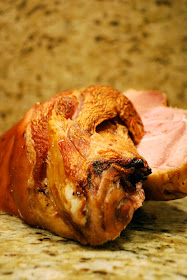Everyone has a favourite cocktail. Mine is a Gin Martini, straight up, dry, two olives. Some people, by their own choice drink Vodka Martinis, even James Bond, but I won't hold it against them. It's just that I find Gin has more flavour. I've tried lots of different Martinis in my time, but my favourite is definitely one made with Hendrick's. Handcrafted in Scotland, Hendrick's makes small batch gin using an infusion of cucumber and rose petals, and even comes in a wonderful squat dark heavy bottle, like something you might find in an old apothecary shop.
The bottle has great character and is sealed with a cork. How many gins do that? I love it. The Hendrick's website and marketing campaign is also wonderfully imaginative, delightfully witty and worth checking out, even if it's just for a giggle.
It's no secret — all gins are infused with different botanicals to give the alcohol its unique flavours and aromas. Bombay Sapphire is spicy. Tanqueray No. 10 is citrusy (my favourite for years), but Hendrick's is just smoother and more delicate. Curiously, the company recommends garnishing their Martinis with a slice of cucumber, rather than an olive or a twist. I wouldn't have believed it, had I not tried it, or been 'instructed' to do so.
The last time I was in London, my step-son Harry, took me to Milk & Honey, a Cocktail Bar and Member's Only Club (after 11pm) in Soho. It's styled after a prohibition era 'speak-easy'. There is no sign, just a big black door with a small sliding eye-level opening where you have to give a secret password. That night it was, "Reservations for Hillier. Three." With that the door opens and you're admitted into a dimly lit, classically decorated Capone-esque lounge. Milk & Honey's niche is their incredible drinks menu, an adventure for any cocktail or martini connoisseur.
Of course, I ordered a Hendrick's Gin Martini, but when I ordered it with an olive, our server pulled up a chair, sat down, and proceeded to explain to me why I didn't really want an olive — I wanted a slice of cucumber instead "luv". Who was I to argue? To my great surprise, he was right. It was better. So if you're a Gin Martini drinker and you haven't tried Hendrick's before, give it a try. As the ads say, "Avoid the obvious. Seek the marvelous." Shucks, even the odd Royal is known to take a tipple of Hendrick's now and then!
Hendrick's Cucumber Martini
Makes 1 helluva martini
1 oz. Hendrick's Gin
3/4 oz. dry vermouth
cucumber slices
Stir vermouth and Hendrick's Gin over ice cubes in a mixing glass. Strain into a martini glass, and garnish with a cucumber slice.















































